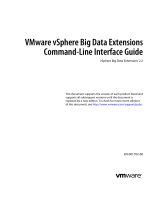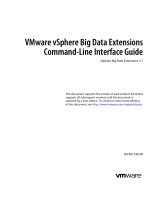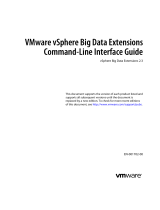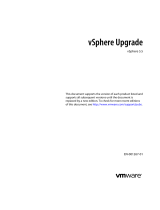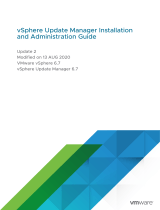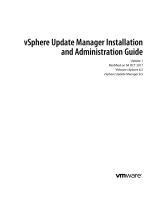Page is loading ...

VMware vSphere Big Data Extensions
Administrator's and User's Guide
vSphere Big Data Extensions 2.3
This document supports the version of each product listed and
supports all subsequent versions until the document is
replaced by a new edition. To check for more recent editions
of this document, see http://www.vmware.com/support/pubs.
EN-TBD-00

VMware vSphere Big Data Extensions Administrator's and User's Guide
2 VMware, Inc.
You can find the most up-to-date technical documentation on the VMware Web site at:
http://www.vmware.com/support/
The VMware Web site also provides the latest product updates.
If you have comments about this documentation, submit your feedback to:
Copyright
©
2013 – 2015 VMware, Inc. All rights reserved. Copyright and trademark information.
This work is licensed under a Creative Commons Attribution-NoDerivs 3.0 United States License
(http://creativecommons.org/licenses/by-nd/3.0/us/legalcode).
VMware, Inc.
3401 Hillview Ave.
Palo Alto, CA 94304
www.vmware.com

Contents
About This Book 7
1
About VMware vSphere Big Data Extensions 9
Getting Started with Big Data Extensions 9
Big Data Extensions and Project Serengeti 10
About Big Data Extensions Architecture 11
About Application Managers 12
2
Installing Big Data Extensions 17
System Requirements for Big Data Extensions 17
Unicode UTF-8 and Special Character Support 20
The Customer Experience Improvement Program 21
Deploy the Big Data Extensions vApp in the vSphere Web Client 22
Install RPMs in the Serengeti Management Server Yum Repository 25
Install the Big Data Extensions Plug-In 26
Configure vCenter Single Sign-On Settings for the Serengeti Management Server 28
Connect to a Serengeti Management Server 28
Install the Serengeti Remote Command-Line Interface Client 29
Access the Serengeti CLI By Using the Remote CLI Client 30
3
Upgrading Big Data Extensions 33
Prepare to Upgrade Big Data Extensions 33
Upgrade the Big Data Extensions Virtual Appliance 34
Upgrade the Big Data Extensions Plug-in 35
Upgrade Big Data Extensions Clusters Using the Serengeti Command-Line Interface 36
Upgrade the Serengeti CLI 36
Add a Remote Syslog Server 37
4
Managing Application Managers 39
Add an Application Manager by Using the vSphere Web Client 39
Modify an Application Manager by Using the Web Client 40
Delete an Application Manager by Using the vSphere Web Client 40
View Application Managers and Distributions by Using the Web Client 40
View Roles for Application Manager and Distribution by Using the Web Client 40
5
Managing Hadoop Distributions 43
Hadoop Distribution Deployment Types 43
Configure a Tarball-Deployed Hadoop Distribution by Using the Serengeti Command-Line
Interface 44
Configuring Yum and Yum Repositories 46
VMware, Inc.
3

6
Managing Node Templates 63
Maintain a Customized Hadoop Template Virtual Machine 63
Create a Node Template Virtual Machine using RHEL Server 6.7 and VMware Tools 64
Support for Multiple Virtual Machine Templates 68
7
Managing the Big Data Extensions Environment 69
Add Specific User Names to Connect to the Serengeti Management Server 69
Change the Password for the Serengeti Management Server 70
Create a User Name and Password for the Serengeti Command-Line Interface 71
Authorize and Audit Commands Run as the Root User 72
Specify a Group of Users in Active Directory or LDAP to Use a Hadoop Cluster 72
Stop and Start Serengeti Services 73
Ports Used for Communication between Big Data Extensions and the vCenter Server 73
Verify the Operational Status of the Big Data Extensions Environment 75
Enter Maintenance Mode to Perform Backup and Restore with the Serengeti Command-Line
Interface Client 83
Backup and Restore the Big Data Extensions Environment 84
8
Managing vSphere Resources for Clusters 87
Add a Resource Pool with the Serengeti Command-Line Interface 87
Remove a Resource Pool with the Serengeti Command-Line Interface 88
Update Resource Pools with the Serengeti Command-Line Interface 88
Add a Datastore in the vSphere Web Client 89
Remove a Datastore in the vSphere Web Client 90
Update Datastores with the Serengeti Command-Line Interface 90
Add a Paravirtual SCSI Controller for System and Swap Disks 91
Add a Network in the vSphere Web Client 92
Modify the DNS Type in the vSphere Web Client 93
Reconfigure a Static IP Network in the vSphere Web Client 93
Remove a Network in the vSphere Web Client 94
9
Creating Hadoop and HBase Clusters 95
About Hadoop and HBase Cluster Deployment Types 97
Hadoop Distributions Supporting MapReduce v1 and MapReduce v2 (YARN) 97
About Cluster Topology 98
About HBase Database Access 98
Create a Big Data Cluster in the vSphere Web Client 99
Create an HBase Only Cluster in Big Data Extensions 102
Create a Cluster with an Application Manager by Using the vSphere Web Client 104
Create a Compute-Only Cluster with a Third Party Application Manager by Using vSphere Web
Client 105
Create a Compute Workers Only Cluster by Using the vSphere Web Client 105
10
Managing Hadoop and HBase Clusters 107
Stop and Start a Cluster in the vSphere Web Client 107
Delete a Cluster in the vSphere Web Client 108
Scale a Cluster in or out by using the vSphere Web Client 108
Scale CPU and RAM in the vSphere Web Client 109
VMware vSphere Big Data Extensions Administrator's and User's Guide
4 VMware, Inc.

Use Disk I/O Shares to Prioritize Cluster Virtual Machines in the vSphere Web Client 110
About vSphere High Availability and vSphere Fault Tolerance 110
Change the User Password on All of the Nodes of a Cluster 111
Reconfigure a Cluster with the Serengeti Command-Line Interface 111
Configure the Number of Data Disks Per Node Group 113
Recover from Disk Failure with the Serengeti Command-Line Interface Client 115
Log in to Hadoop Nodes with the Serengeti Command-Line Interface Client 115
11
Monitoring the Big Data Extensions Environment 117
Enable the Big Data Extensions Data Collector 117
Disable the Big Data Extensions Data Collector 118
View Serengeti Management Server Initialization Status 118
View Provisioned Clusters in the vSphere Web Client 119
View Cluster Information in the vSphere Web Client 120
Monitor the HDFS Status in the vSphere Web Client 121
Monitor MapReduce Status in the vSphere Web Client 121
Monitor HBase Status in the vSphere Web Client 122
12
Accessing Hive Data with JDBC or ODBC 123
Configure Hive to Work with JDBC 123
Configure Hive to Work with ODBC 125
13
Big Data Extensions Security Reference 127
Services, Network Ports, and External Interfaces 127
Big Data Extensions Configuration Files 129
Big Data Extensions Public Key, Certificate, and Keystore 130
Big Data Extensions Log Files 130
Big Data Extensions User Accounts 131
Security Updates and Patches 131
14
Troubleshooting 133
Log Files for Troubleshooting 134
Configure Serengeti Logging Levels 134
Collect Log Files for Troubleshooting 135
Troubleshooting Cluster Creation Failures 136
Big Data Extensions Virtual Appliance Upgrade Fails 142
Upgrade Cluster Error When Using Cluster Created in Earlier Version of Big Data Extensions 143
Unable to Connect the Big Data Extensions Plug-In to the Serengeti Server 143
vCenter Server Connections Fail to Log In 144
Management Server Cannot Connect to vCenter Server 144
SSL Certificate Error When Connecting to Non-Serengeti Server with the vSphere Console 145
Cannot Restart or Reconfigure a Cluster For Which the Time Is Not Synchronized 145
Cannot Restart or Reconfigure a Cluster After Changing Its Distribution 146
Virtual Machine Cannot Get IP Address and Command Fails 146
Cannot Change the Serengeti Server IP Address From the vSphere Web Client 147
A New Plug-In Instance with the Same or Earlier Version Number as a Previous Plug-In Instance
Does Not Load 147
Host Name and FQDN Do Not Match for Serengeti Management Server 148
Contents
VMware, Inc. 5

Serengeti Operations Fail After You Rename a Resource in vSphere 149
Big Data Extensions Server Does Not Accept Resource Names With Two or More Contiguous
White Spaces 149
Non-ASCII characters are not displayed correctly 149
MapReduce Job Fails to Run and Does Not Appear In the Job History 149
Cannot Submit MapReduce Jobs for Compute-Only Clusters with External Isilon HDFS 150
MapReduce Job Stops Responding on a PHD or CDH4 YARN Cluster 151
Cannot Download the Package When Using Downloadonly Plugin 151
Cannot Find Packages When You Use Yum Search 151
Remove the HBase Rootdir in HDFS Before You Delete the HBase Only Cluster 151
Index 153
VMware vSphere Big Data Extensions Administrator's and User's Guide
6 VMware, Inc.

About This Book
VMware vSphere Big Data Extensions Administrator's and User's Guide describes how to install VMware
vSphere Big Data Extensions™ within your vSphere environment, and how to manage and monitor Hadoop
and HBase clusters using the Big Data Extensions plug-in for vSphere Web Client.
VMware vSphere Big Data Extensions Administrator's and User's Guide also describes how to perform Hadoop
and HBase operations using the VMware Serengeti™ Command-Line Interface Client, which provides a
greater degree of control for certain system management and big data cluster creation tasks.
Intended Audience
This guide is for system administrators and developers who want to use Big Data Extensions to deploy and
manage Hadoop clusters. To successfully work with Big Data Extensions, you should be familiar with
VMware
®
vSphere
®
and Hadoop and HBase deployment and operation.
VMware Technical Publications Glossary
VMware Technical Publications provides a glossary of terms that might be unfamiliar to you. For definitions
of terms as they are used in VMware technical documentation, go to
http://www.vmware.com/support/pubs.
VMware, Inc.
7

VMware vSphere Big Data Extensions Administrator's and User's Guide
8 VMware, Inc.

About VMware vSphere Big Data
Extensions 1
VMware vSphere Big Data Extensions lets you deploy and centrally operate big data clusters running on
VMware vSphere. Big Data Extensions simplifies the Hadoop and HBase deployment and provisioning
process, and gives you a real time view of the running services and the status of their virtual hosts. It
provides a central place from which to manage and monitor your big data cluster, and incorporates a full
range of tools to help you optimize cluster performance and utilization.
This chapter includes the following topics:
n
“Getting Started with Big Data Extensions,” on page 9
n
“Big Data Extensions and Project Serengeti,” on page 10
n
“About Big Data Extensions Architecture,” on page 11
n
“About Application Managers,” on page 12
Getting Started with Big Data Extensions
Big Data Extensions lets you deploy big data clusters. The tasks in this section describe how to set up
VMware vSphere
®
for use with Big Data Extensions, deploy the Big Data Extensions vApp, access the
VMware vCenter Server
®
and command-line interface (CLI) administrative consoles, and configure a
Hadoop distribution for use with Big Data Extensions.
Prerequisites
n
Understand what Project Serengeti
®
and Big Data Extensions is so that you know how they fit into your
big data workflow and vSphere environment.
n
Verify that the Big Data Extensions features that you want to use, such as compute-only or data-
compute separated, are supported by Big Data Extensions for the Hadoop distribution that you want to
use.
n
Understand which features are supported by your Hadoop distribution.
Procedure
1 Do one of the following.
n
Install Big Data Extensions for the first time. Review the system requirements, install vSphere, and
install the Big Data Extensions components: Big Data Extensions vApp, Big Data Extensions plug-
in for vCenter Server, and Serengeti CLI Client.
n
Upgrade Big Data Extensions from a previous version. Perform the upgrade steps.
VMware, Inc.
9

2 (Optional) Install and configure a distribution other than Apache Bigtop for use with
Big Data Extensions.
Apache Bigtop is included in the Serengeti Management Server, but you can use any Hadoop
distribution that Big Data Extensions supports.
What to do next
After you have successfully installed and configured your Big Data Extensions environment, you can
perform the following additional tasks.
n
Stop and start the Serengeti services, create user accounts, manage passwords, and log in to cluster
nodes to perform troubleshooting.
n
Manage the vSphere resource pools, datastores, and networks that you use to create Hadoop and HBase
clusters.
n
Create, provision, and manage big data clusters.
n
Monitor the status of the clusters that you create, including their datastores, networks, and resource
pools, through the vSphere Web Client and the Serengeti Command-Line Interface.
n
On your Big Data clusters, run HDFS commands, Hive and Pig scripts , and MapReduce jobs, and
access Hive data.
n
If you encounter any problems when using Big Data Extensions, see Chapter 14, “Troubleshooting,” on
page 133.
Big Data Extensions and Project Serengeti
Big Data Extensions runs on top of Project Serengeti, the open source project initiated by VMware to
automate the deployment and management of Hadoop and HBase clusters on virtual environments such as
vSphere.
Big Data Extensions and Project Serengeti provide the following components.
Project Serengeti
An open source project initiated by VMware, Project Serengeti lets users
deploy and manage big data clusters in a vCenter Server managed
environment. The major components are the Serengeti Management Server,
which provides cluster provisioning, software configuration, and
management services; and a command-line interface. Project Serengeti is
made available under the Apache 2.0 license, under which anyone can
modify and redistribute Project Serengeti according to the terms of the
license.
Serengeti Management
Server
Provides the framework and services to run Big Data clusters on vSphere.
The Serengeti Management Server performs resource management, policy-
based virtual machine placement, cluster provisioning, software
configuration management, and environment monitoring.
VMware vSphere Big Data Extensions Administrator's and User's Guide
10 VMware, Inc.

Serengeti Command-
Line Interface Client
The command-line interface (CLI) client provides a comprehensive set of
tools and utilities with which to monitor and manage your Big Data
deployment. If you are using the open source version of Serengeti without
Big Data Extensions, the CLI is the only interface through which you can
perform administrative tasks. For more information about the CLI, see the
VMware vSphere Big Data Extensions Command-Line Interface Guide.
Big Data Extensions
The commercial version of the open source Project Serengeti from VMware,
Big Data Extensions, is delivered as a vCenter Server Appliance.
Big Data Extensions includes all the Project Serengeti functions and the
following additional features and components.
n
Enterprise level support from VMware.
n
Bigtop distribution from the Apache community.
NOTE VMware provides the Hadoop distribution as a convenience but
does not provide enterprise-level support. The Apache Bigtop
distribution is supported by the open source community.
n
The Big Data Extensions plug-in, a graphical user interface integrated
with vSphere Web Client. This plug-in lets you perform common
Hadoop infrastructure and cluster management administrative tasks.
About Big Data Extensions Architecture
The Serengeti Management Server and Hadoop Template virtual machine work together to configure and
provision big data clusters.
Figure 1‑1. Big Data Extensions Architecture
CLI GUI
Rest API
VM and Application
Provisioning Framework
Software Management SPI
Default
adapter
Cloudera
adapter
Ambari
adapter
Software
Management
Thrift Service
Cloudera
Manager
Server
Ambari
Server
Chapter 1 About VMware vSphere Big Data Extensions
VMware, Inc. 11

Big Data Extensions performs the following steps to deploy a big data cluster.
1 The Serengeti Management Server searches for ESXi hosts with sufficient resources to operate the
cluster based on the configuration settings that you specify, and then selects the ESXi hosts on which to
place Hadoop virtual machines.
2 The Serengeti Management Server sends a request to the vCenter Server to clone and configure virtual
machines to use with the big data cluster.
3 The Serengeti Management Server configures the operating system and network parameters for the
new virtual machines.
4 Each virtual machine downloads the Hadoop software packages and installs them by applying the
distribution and installation information from the Serengeti Management Server.
5 The Serengeti Management Server configures the Hadoop parameters for the new virtual machines
based on the cluster configuration settings that you specify.
6 The Hadoop services are started on the new virtual machines, at which point you have a running
cluster based on your configuration settings.
About Application Managers
You can use Cloudera Manager, Apache Ambari, and the default application manager to provision and
manage clusters with VMware vSphere Big Data Extensions.
After you add a new Cloudera Manager or Ambari application manager to Big Data Extensions, you can
redirect your software management tasks, including monitoring and managing clusters, to that application
manager.
You can use an application manager to perform the following tasks:
n
List all available vendor instances, supported distributions, and configurations or roles for a specific
application manager and distribution.
n
Create clusters.
n
Monitor and manage services from the application manager console.
Check the documentation for your application manager for tool-specific requirements.
Restrictions
The following restrictions apply to Cloudera Manager and Ambari application managers:
n
To add an application manager with HTTPS, use the FQDN instead of the URL.
n
You cannot rename a cluster that was created with a Cloudera Manager or Ambari application
manager.
n
You cannot change services for a big data cluster from Big Data Extensions if the cluster was created
with Ambari or Cloudera Manager application manager.
n
To change services, configurations, or both, you must make the changes from the application manager
on the nodes.
If you install new services, Big Data Extensions starts and stops the new services together with old
services.
n
If you use an application manager to change services and big data cluster configurations, those changes
cannot be synced from Big Data Extensions. The nodes that you create with Big Data Extensions do not
contain the new services or configurations.
VMware vSphere Big Data Extensions Administrator's and User's Guide
12 VMware, Inc.

Services and Operations Supported by the Application Managers
If you use Cloudera Manager or Apache Ambari with Big Data Extensions, there are several additional
services that are available for your use.
Supported Application Managers and Distributions
Big Data Extensions supports certain application managers and Hadoop distributions. In some cases not all
features and operations are supported by certain versions of application mangers. The table below indicates
which features are available when using the listed application mangers.
Table 1‑1. Supported application managers and Hadoop distributions
Supported features
and operations Cloudera Manager
Hortonworks
Ambari Pivotal Ambari
Default Application
Manager
Supported Versions 5.3-5.4 2.0-2.1 1.7 2.3
Supported
Distributions
CDH 5.3-5.4, OneFS
7.1-7.2
HDP 2.2-2.3, OneFS*
7.1-7.2
PHD 3.0, OneFS*
7.1-7.2
Bigtop 1.0, CDH
5.3-5.4, HDP 2.1, PHD
2.0-2.1, MapR 4.1-5.0,
and OneFS 7.1-7.2
Automatic
Deployment
X X X X
Cluster List, Stop,
Start, Export, and
Resume
X X X X
vSphere High
Availability
X X X X
vSphere Fault
Tolerance
X X X X
Multiple Networks Multiple networks
are not supported.
Multiple networks
are not supported.
Multiple networks
are not supported.
Not supported when
using MapR.
Data-Compute
Combined
X X X X
Data-Compute
Separation
X X X X
Compute-only X Ambari can
provision compute-
only clusters when
using Isilon OneFS.
Refer to the EMC
Isilon Hadoop
Starter Kit for
Hortonworks
documentation for
information on
configuring Ambari
and Isilon OneFS.
Ambari can
provision compute-
only clusters when
using Isilon OneFS.
Refer to the EMC
Isilon Hadoop
Starter Kit for
Hortonworks
documentation for
information on
configuring Ambari
and Isilon OneFS.
Not supported when
using MapR.
Hbase Cluster X X X X
Hbase-only Not supported when
using MapR.
Chapter 1 About VMware vSphere Big Data Extensions
VMware, Inc. 13

Table 1‑1. Supported application managers and Hadoop distributions (Continued)
Supported features
and operations Cloudera Manager
Hortonworks
Ambari Pivotal Ambari
Default Application
Manager
Hadoop
Topology/HVE
X X X Topology is not
supported when using
MapR.
HVE is only
supported when using
PHD.
Hadoop Configuration Supported through
the Web interface of
the application
manager.
Supported through
the Web interface of
the application
manager.
Supported through
the Web interface of
the application
manager.
Not supported when
using MapR.
Hadoop Ecosystem
Components
Full stack through
Cloudera Manager.
Full stack through
Ambari
Full stack through
Ambari..
Pig, Hive, Hive Server,
and Zookeeper.
Support for Hadoop Distributions in Isilon OneFS
If you wish to use Isilon OneFS, first verify if your Hadoop distribution is compatible with OneFS. See
Supported Hadoop Distributions in OneFS on the EMC Website.
NOTE Big Data Extensions does not natively support the provisioning of compute-only clusters with
Ambari Manager. However Ambari can provision compute-only clusters when using Isilon OneFS. Refer to
the EMC Isilon Hadoop Starter Kit for Hortonworks documentation for information on configuring Ambari
and Isilon OneFS.
Services Supported on Cloudera Manager and Ambari
Table 1‑2. Services supported on Cloudera Manager and Ambari
Service Name Cloudera Manager 5.3, 5.4 Ambari 1.6, 1.7
Falcon X
Flume X X
Ganglia X
HBase X X
HCatalog X
HDFS X X
Hive X X
Hue X X
Impala X
MapReduce X X
Nagios X
Oozie X X
Pig X
Sentry
Solr X
Spark X
Sqoop X X
Storm X
VMware vSphere Big Data Extensions Administrator's and User's Guide
14 VMware, Inc.

Table 1‑2. Services supported on Cloudera Manager and Ambari (Continued)
Service Name Cloudera Manager 5.3, 5.4 Ambari 1.6, 1.7
TEZ X
WebHCAT X
YARN X X
Zookeeper X X
About Service Level vSphere High Availability for Ambari
Ambari supports NameNode HA, however, you must configure NameNode HA for use with your Hadoop
deployment. See NameNode High Availability for Hadoop in the Hortonworks documentation.
About Service Level vSphere High Availability for Cloudera
The Cloudera distributions offer the following support for Service Level vSphere HA.
n
Cloudera using MapReduce v1 provides service level vSphere HA support for JobTracker.
n
Cloudera provides its own service level HA support for NameNode through HDFS2.
For information about how to use an application manager with the CLI, see the VMware vSphere Big Data
Extensions Command-Line Interface Guide.
Chapter 1 About VMware vSphere Big Data Extensions
VMware, Inc. 15

VMware vSphere Big Data Extensions Administrator's and User's Guide
16 VMware, Inc.

Installing Big Data Extensions 2
To install Big Data Extensions so that you can create and provision big data clusters, you must install the
Big Data Extensions components in the order described.
What to do next
If you want to create clusters on any Hadoop distribution other than Apache Bigtop, which is included in
theSerengeti Management Server, install and configure the distribution for use with Big Data Extensions.
This chapter includes the following topics:
n
“System Requirements for Big Data Extensions,” on page 17
n
“Unicode UTF-8 and Special Character Support,” on page 20
n
“The Customer Experience Improvement Program,” on page 21
n
“Deploy the Big Data Extensions vApp in the vSphere Web Client,” on page 22
n
“Install RPMs in the Serengeti Management Server Yum Repository,” on page 25
n
“Install the Big Data Extensions Plug-In,” on page 26
n
“Configure vCenter Single Sign-On Settings for the Serengeti Management Server,” on page 28
n
“Connect to a Serengeti Management Server,” on page 28
n
“Install the Serengeti Remote Command-Line Interface Client,” on page 29
n
“Access the Serengeti CLI By Using the Remote CLI Client,” on page 30
System Requirements for Big Data Extensions
Before you begin the Big Data Extensions deployment tasks, your system must meet all of the prerequisites
for vSphere, clusters, networks, storage, hardware, and licensing.
Big Data Extensions requires that you install and configure vSphere and that your environment meets
minimum resource requirements. Make sure that you have licenses for the VMware components of your
deployment.
vSphere Requirements
Before you install Big Data Extensions, set up the following VMware
products.
n
Install vSphere 5.5 (or later) Enterprise or Enterprise Plus.
VMware, Inc. 17

n
When you install Big Data Extensions on vSphere 5.5 or later, use
VMware
®
vCenter™ Single Sign-On to provide user authentication.
When logging in to vSphere 5.5 or later you pass authentication to the
vCenter Single Sign-On server, which you can configure with multiple
identity sources such as Active Directory and OpenLDAP. On successful
authentication, your user name and password is exchanged for a
security token that is used to access vSphere components such as
Big Data Extensions.
n
If your vCenter Server uses a FQDN, ensure you configure it correctly
when you install vCenter Server.
n
Configure all ESXi hosts to use the same Network Time Protocol (NTP)
server.
n
On each ESXi host, add the NTP server to the host configuration, and
from the host configuration's Startup Policy list, select Start and stop
with host. The NTP daemon ensures that time-dependent processes
occur in sync across hosts.
Cluster Settings
Configure your cluster with the following settings.
n
Enable vSphere HA and VMware vSphere
®
Distributed Resource
Scheduler™.
n
Enable Host Monitoring.
n
Enable admission control and set the policy you want. The default
policy is to tolerate one host failure.
n
Set the virtual machine restart priority to high.
n
Set the virtual machine monitoring to virtual machine and application
monitoring.
n
Set the monitoring sensitivity to high.
n
Enable vMotion and Fault Tolerance logging.
n
All hosts in the cluster have Hardware VT enabled in the BIOS.
n
The Management Network VMkernel Port has vMotion and Fault
Tolerance logging enabled.
Network Settings
Big Data Extensions can deploy clusters on a single network or use multiple
networks. The environment determines how port groups that are attached to
NICs are configured and which network backs each port group.
You can use either a vSwitch or vSphere Distributed Switch (vDS) to provide
the port group backing a Serengeti cluster. vDS acts as a single virtual switch
across all attached hosts while a vSwitch is per-host and requires the port
group to be configured manually.
When you configure your networks to use with Big Data Extensions, verify
that the following ports are open as listening ports.
n
Ports 8080 and 8443 are used by the Big Data Extensions plug-in user
interface and the Serengeti Command-Line Interface Client.
n
Port 5480 is used by vCenter Single Sign-On for monitoring and
management.
n
Port 22 is used by SSH clients.
VMware vSphere Big Data Extensions Administrator's and User's Guide
18 VMware, Inc.

n
To prevent having to open a network firewall port to access Hadoop
services, log into the Hadoop client node, and from that node you can
access your cluster.
n
To connect to the internet (for example, to create an internal yum
repository from which to install Hadoop distributions), you may use a
proxy.
n
To enable communications, be sure that firewalls and web filters do not
block the Serengeti Management Server or other Serengeti nodes.
Direct Attached Storage
Attach and configure direct attached storage on the physical controller to
present each disk separately to the operating system. This configuration is
commonly described as Just A Bunch Of Disks (JBOD). Create VMFS
datastores on direct attached storage using the following disk drive
recommendations.
n
8-12 disk drives per host. The more disk drives per host, the better the
performance.
n
1-1.5 disk drives per processor core.
n
7,200 RPM disk Serial ATA disk drives.
Do not use
Big Data Extensions in
conjunction with
vSphere Storage DRS
Big Data Extensions places virtual machines on hosts according to available
resources, Hadoop best practices, and user defined placement policies prior
to creating virtual machines. For this reason, you should not deploy
Big Data Extensions on vSphere environments in combination with Storage
DRS. Storage DRS continuously balances storage space usage and storage I/O
load to meet application service levels in specific environments. If Storage
DRS is used with Big Data Extensions, it will disrupt the placement policies
of your Big Data cluster virtual machines.
Migrating virtual
machines in vCenter
Server may disrupt the
virtual machine
placement policy
Big Data Extensions places virtual machines based on available resources,
Hadoop best practices, and user defined placement policies that you specify.
For this reason, DRS is disabled on all the virtual machines created within
the Big Data Extensions environment. While this prevents virtual machines
from being automatically migrated by vSphere, it does not prevent you from
inadvertently moving virtual machines using the vCenter Server user
interface. This may break the Big Data Extensions defined placement policy.
For example, this may disrupt the number of instances per host and group
associations.
Resource Requirements
for the vSphere
Management Server and
Templates
n
Resource pool with at least 27.5GB RAM.
n
40GB or more (recommended) disk space for the management server
and Hadoop template virtual disks.
Resource Requirements
for the Hadoop Cluster
n
Datastore free space is not less than the total size needed by the Hadoop
cluster, plus swap disks for each Hadoop node that is equal to the
memory size requested.
n
Network configured across all relevant ESXi hosts, and has connectivity
with the network in use by the management server.
n
vSphere HA is enabled for the master node if vSphere HA protection is
needed. To use vSphere HA or vSphere FT to protect the Hadoop master
node, you must use shared storage.
Chapter 2 Installing Big Data Extensions
VMware, Inc. 19

Hardware Requirements
for the vSphere and
Big Data Extensions
Environment
Host hardware is listed in the VMware Compatibility Guide. To run at optimal
performance, install your vSphere and Big Data Extensions environment on
the following hardware.
n
Dual Quad-core CPUs or greater that have Hyper-Threading enabled. If
you can estimate your computing workload, consider using a more
powerful CPU.
n
Use High Availability (HA) and dual power supplies for the master
node's host machine.
n
4-8 GBs of memory for each processor core, with 6% overhead for
virtualization.
n
Use a 1GB Ethernet interface or greater to provide adequate network
bandwidth.
Tested Host and Virtual
Machine Support
The maximum host and virtual machine support that has been confirmed to
successfully run with Big Data Extensions is 256 physical hosts running a
total of 512 virtual machines.
vSphere Licensing
You must use a vSphere Enterprise license or above to use VMware vSphere
HA and vSphere DRS.
Unicode UTF-8 and Special Character Support
Big Data Extensions supports internationalization (I18N) level 3. However, there are resources you specify
that do not provide UTF-8 support. You can use only ASCII attribute names consisting of alphanumeric
characters and underscores (_) for these resources.
Big Data Extensions Supports Unicode UTF-8
vCenter Server resources you specify using both the CLI and vSphere Web Client can be expressed with
underscore (_), hyphen (-), blank spaces, and all letters and numbers from any language. For example, you
can specify resources such as datastores labeled using non-English characters.
When using a Linux operating system, you should configure the system for use with UTF-8 encoding
specific to your locale. For example, to use U.S. English, specify the following locale encoding: en_US.UTF-8.
See your vendor's documentation for information on configuring UTF-8 encoding for your Linux
environment.
Special Character Support
The following vCenter Server resources can have a period (.) in their name, letting you select them using
both the CLI and vSphere Web Client.
n
portgroup name
n
cluster name
n
resource pool name
n
datastore name
The use of a period is not allowed in the Serengeti resource name.
VMware vSphere Big Data Extensions Administrator's and User's Guide
20 VMware, Inc.
/


